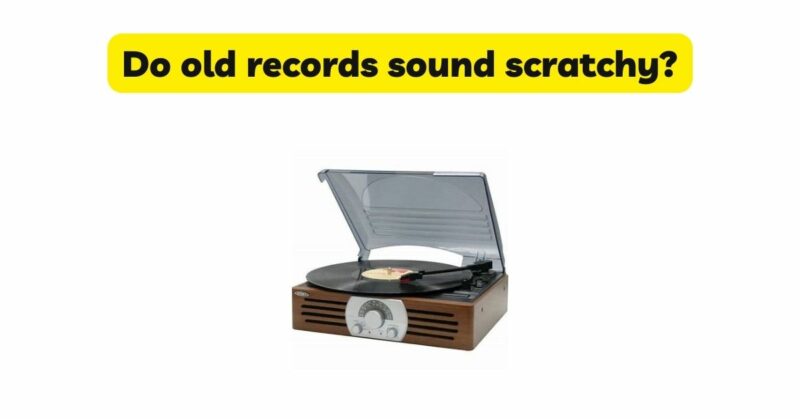Old vinyl records possess a unique charm that captivates music enthusiasts with their nostalgic appeal. However, it is not uncommon for these records to exhibit a scratchy sound during playback, which can diminish the listening experience. In this article, we will delve into the reasons why old records may sound scratchy and explore the factors that contribute to this phenomenon. By understanding the nature of scratchiness in old records, we can appreciate their historical significance while implementing techniques to minimize its impact for a more enjoyable listening experience.
- Surface Damage: One of the primary causes of scratchiness in old records is surface damage. Over time, records may accumulate scratches, scuffs, or abrasions that affect the smooth flow of the stylus along the grooves. These imperfections can cause irregularities in the sound reproduction, resulting in scratchy sounds. Proper handling, storage, and maintenance practices, such as using protective sleeves and avoiding rough handling, can help minimize surface damage.
- Wear and Tear: Old records that have been heavily played or improperly handled may exhibit increased wear and tear, leading to a scratchy sound. With each playback, the stylus gradually wears away minute amounts of the record’s surface. Over time, this wear can cause groove distortions or inconsistencies that introduce scratchiness during playback. Regular cleaning, careful handling, and proper stylus maintenance can help mitigate wear and tear and reduce scratchiness.
- Dust and Debris: Dust and debris present on the record surface can interfere with the smooth tracking of the stylus, resulting in scratchy sounds. As the stylus encounters these particles, it can produce frictional noise that manifests as scratchiness in the audio. Regular cleaning of the record with an anti-static brush or record cleaning solution can help remove dust and debris, reducing the likelihood of scratchy playback.
- Record Condition: The overall condition of an old record can influence its sound quality, including the presence of scratchiness. Records that have been poorly stored, exposed to extreme temperature or humidity, or subjected to suboptimal cleaning methods may exhibit increased scratchiness. Proper storage in a controlled environment, regular cleaning using appropriate methods, and handling records with care can help maintain their condition and minimize scratchiness.
- Stylus Condition: The condition of the stylus, or needle, plays a significant role in the playback quality of old records. A worn or damaged stylus may struggle to accurately track the grooves, leading to uneven sound reproduction and scratchiness. Regular inspection and replacement of the stylus, in accordance with the manufacturer’s guidelines, are essential for optimal playback performance. Proper cleaning of the stylus with a stylus brush or cleaning solution can also help reduce scratchiness caused by debris buildup.
- Playback Equipment: The quality and condition of the playback equipment, including the turntable, tonearm, and cartridge, can affect the scratchiness of old records. Low-quality or poorly maintained equipment may introduce mechanical noise or tracking issues that result in scratchy playback. Investing in a high-quality turntable, properly calibrated tonearm, and compatible cartridge can significantly improve playback performance and reduce scratchiness.
- Genre and Vintage Recordings: The scratchiness experienced in old records can vary depending on the genre and the era of the recordings. Older recordings or specific genres, such as blues, jazz, or folk, may have been captured using vintage equipment and techniques that contribute to the inherent scratchy or raw sound. In these cases, scratchiness can be considered a characteristic of the recording rather than a flaw. Understanding the genre and appreciating the historical context can help embrace the scratchiness as part of the authenticity and charm of vintage recordings.
- Listener Expectations: Listener expectations and subjective perception play a crucial role in how scratchiness is perceived. Some listeners may find the scratchy sound of old records endearing, as it adds to the vintage character and nostalgic appeal. Others may prefer a cleaner and more pristine sound and perceive scratchiness as undesirable. Recognizing and accepting the subjective nature of perception allows individuals to approach scratchiness with an open mind and appreciate its significance in the vinyl listening experience.
Conclusion: Scratchiness in old records can be attributed to factors such as surface damage, wear and tear, dust and debris, record condition, stylus condition, playback equipment, genre characteristics, and listener expectations. While it may not be possible to completely eliminate scratchiness, adopting proper record handling, storage, and cleaning practices, along with regular stylus maintenance, can help minimize its impact. Understanding the historical context and genre characteristics can also foster appreciation for scratchiness as part of the unique charm of vintage recordings. By embracing the scratchiness and focusing on the overall listening experience, we can rediscover the magic of old records and enjoy the sonic journey they offer.


